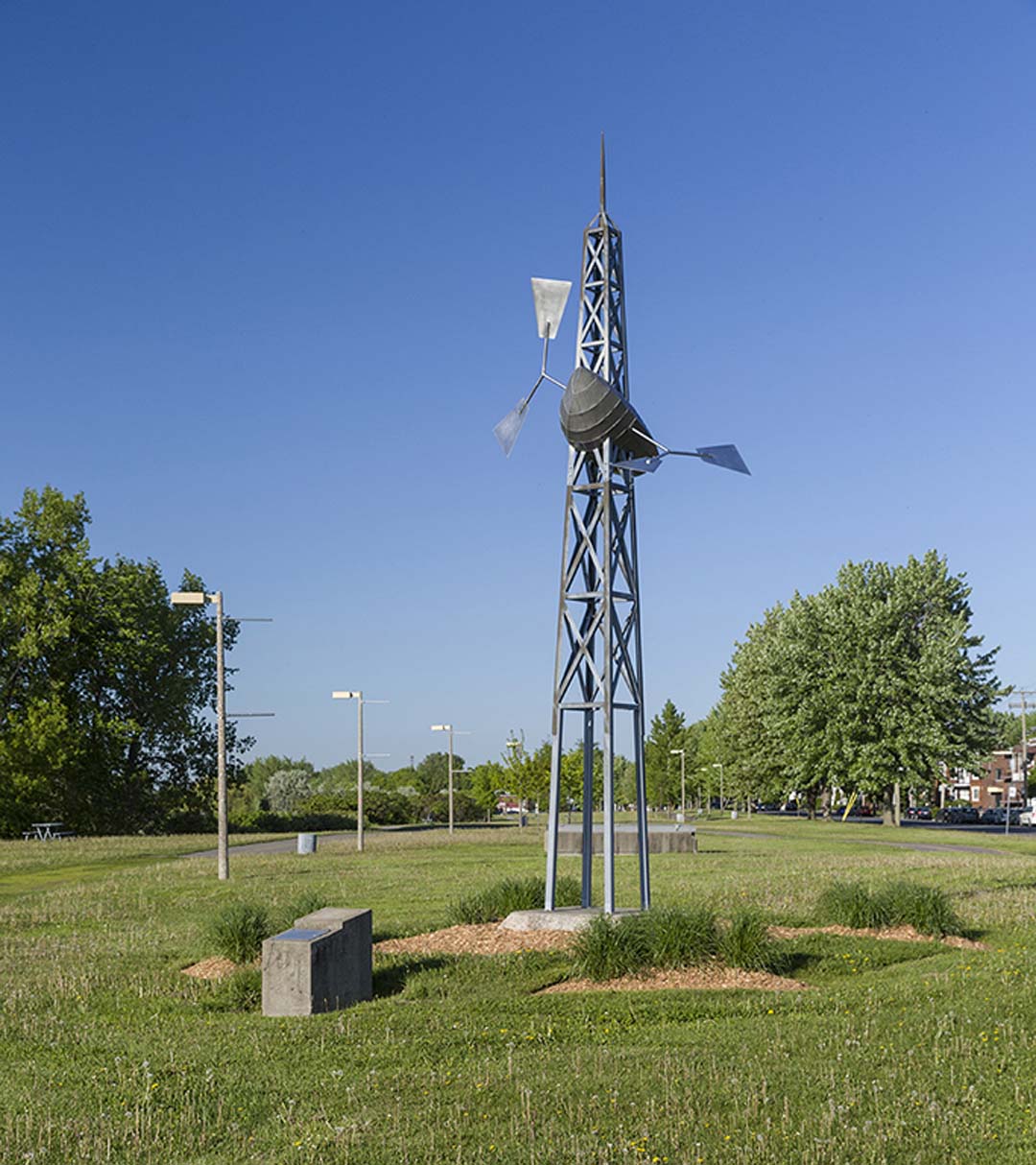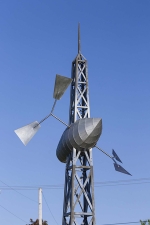Catherine Widgery
Wind Boat
1990
Presentation of the artwork
Beside the promenade bordering the St. Lawrence, in LaSalle, rises a metal tower to which are attached a shape evoking a boat and a mechanism that uses the wind to turn four propeller blades. Widgery took inspiration from one of the most important historical monuments in the borough, the large windmill built by William Fleming in 1927, to pay tribute to the area’s industrial heritage. The work also testifies, however, to LaSalle’s modern developments with this structure, which refers to the city’s engineering works – the nearby bridges and electricity pylons. The sculpture is therefore presented as a beacon to the coexistence of past and present.
This evocation of industrial development does not, however, exclude a more humanistic interpretation of the artwork. In Widgery’s view, “Like the old windmill today, the visual language of Wind Boat is more symbolic than literal. It also lends itself to multiple interpretations, including that illustrating the dilemma of the human condition: human thought opposed to intuitive impulses.” – Catherine Widgery, 1990 1.
1. “Catherine Widgery,” in Sculpture: Séduction 90: Le Rayonnement d’un Art dans Les Jardins Municipaux de la Communauté Urbaine de Montréal, ed. Janou Gagnon (Montréal: Conseil de la sculpture du Québec, 1990), 36 (our translation).
Associated events
The work was created during Sculpture: Séduction 90, an event that took place in 16 Montréal Urban Community parks from 15 June to 30 September 1990. Organized by the Conseil de la sculpture du Québec, its goal was to present “a permanent itinerary of large-format sculptures integrated with the environment of municipal parks.”
Catherine Widgery
Born in Pittsburgh, Pennsylvania, Catherine Widgery graduated from Yale University in 1975. Her sculptures beckon to the senses of viewers because of their integration of light and wind.
Widgery’s public art projects update the relationship between nature and human culture and encourage its integration with the environment. This is the case for Light Storm (2005), produced at the Mesa Arts Centre in Arizona, and Pass Through The Land (2001), in Denver, Colorado.
Widgery’s public art projects update the relationship between nature and human culture and encourage its integration with the environment. This is the case for Light Storm (2005), produced at the Mesa Arts Centre in Arizona, and Pass Through The Land (2001), in Denver, Colorado.
Awards and honours
- premier prix pour Tidal Song, TGK 2012 International Competition, 2012
- membre, Académie Royale des arts du Canada, 2002
- Merit Award for excellence in design, The Advertising and Design Club of Canada for the, 1998
- Cum Laude & Special Distinction in Fine Arts, Yale University, 1975
- Walker Prize, Fine Arts Faculty, Yale University., 1975
Presentation of the artwork
Beside the promenade bordering the St. Lawrence, in LaSalle, rises a metal tower to which are attached a shape evoking a boat and a mechanism that uses the wind to turn four propeller blades. Widgery took inspiration from one of the most important historical monuments in the borough, the large windmill built by William Fleming in 1927, to pay tribute to the area’s industrial heritage. The work also testifies, however, to LaSalle’s modern developments with this structure, which refers to the city’s engineering works – the nearby bridges and electricity pylons. The sculpture is therefore presented as a beacon to the coexistence of past and present.
This evocation of industrial development does not, however, exclude a more humanistic interpretation of the artwork. In Widgery’s view, “Like the old windmill today, the visual language of Wind Boat is more symbolic than literal. It also lends itself to multiple interpretations, including that illustrating the dilemma of the human condition: human thought opposed to intuitive impulses.” – Catherine Widgery, 1990 1.
1. “Catherine Widgery,” in Sculpture: Séduction 90: Le Rayonnement d’un Art dans Les Jardins Municipaux de la Communauté Urbaine de Montréal, ed. Janou Gagnon (Montréal: Conseil de la sculpture du Québec, 1990), 36 (our translation).
Associated events
The work was created during Sculpture: Séduction 90, an event that took place in 16 Montréal Urban Community parks from 15 June to 30 September 1990. Organized by the Conseil de la sculpture du Québec, its goal was to present “a permanent itinerary of large-format sculptures integrated with the environment of municipal parks.”
Catherine Widgery
Born in Pittsburgh, Pennsylvania, Catherine Widgery graduated from Yale University in 1975. Her sculptures beckon to the senses of viewers because of their integration of light and wind.
Widgery’s public art projects update the relationship between nature and human culture and encourage its integration with the environment. This is the case for Light Storm (2005), produced at the Mesa Arts Centre in Arizona, and Pass Through The Land (2001), in Denver, Colorado.
Widgery’s public art projects update the relationship between nature and human culture and encourage its integration with the environment. This is the case for Light Storm (2005), produced at the Mesa Arts Centre in Arizona, and Pass Through The Land (2001), in Denver, Colorado.
Awards and honours
- premier prix pour Tidal Song, TGK 2012 International Competition, 2012
- membre, Académie Royale des arts du Canada, 2002
- Merit Award for excellence in design, The Advertising and Design Club of Canada for the, 1998
- Cum Laude & Special Distinction in Fine Arts, Yale University, 1975
- Walker Prize, Fine Arts Faculty, Yale University., 1975






